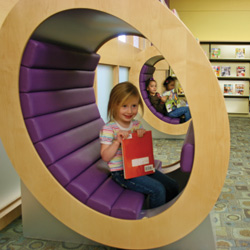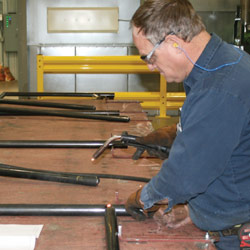The Peoria Public Library is entering a new era of service with the opening of the new north branch and the remodeled main library.
Along with cassette tapes, VCRs and (soon enough) landline phones, some speculated that the venerable library, too, would one day become no more than a “quaint reminder of a bygone era,” according to Inventing the Future of the Peoria Public Library, the library’s long-range development plan. But today, more individuals are visiting the library than ever before. Why?
Libraries have caught up with the demands of a technology-driven, gadget-friendly, iPod generation. Gone are the days of card catalogs, paper research and stacks of dusty hardbacks. Welcome to the 21st century library.
The Changing Peoria
While the concept of a 21st century library might have sounded like something out of a Star Trek movie to someone combing through a card catalog in the 1970s, it has now found a home in Peoria. Adults who love to spend their Saturday afternoons lounging with a good book or students cramming in last-minute research needn’t look any further to find what they need. Indeed, the blueprints for the library’s expansion have been marvelously executed to fashion a learning center encompassing all the features and amenities of the 21st century while respectfully preserving Peoria’s past.
“[The library project] is the culmination of a tremendous group of people who gave a lot of their time,” says Library Director Ed Szynaka. “It’s really been a very public, community-wide, open process. The master plan that was prepared really identified the changing Peoria.”
Making It Easy
Szynaka says that all five library locations reflect the changes of the 21st century, with the same features and amenities at each branch. “One of our goals was to provide equal levels of service to all parts of the community to make it as easy as possible for visitors to find what they need.”
“A 21st century library is designed for ease of use,” adds Public Relations Supervisor Trisha Noack. “The community created the plan [for the new library] through their desire to have strong, up-to-date library service, and I believe the buildings we are creating and the new services we offer, both in the building and on our website, will meet those needs.”
According to the long-range plan, the library must “reinvent what it is and does.” The combination of 21st century criteria with an easy-to-access service and technology system has culminated in the development of a hybrid of standardized libraries throughout the city.
21st century upgrades have given the library an ambiance that makes visitors feel welcome. The entrance to the library is now located next to the parking lot, preventing customers from having to walk a long way in rain or snow. The checkout area and help desk are now positioned away from the front entrance. “Customers weren’t comfortable walking into the library and having the main service desk with three or four librarians right there in front of them,” says Noack, adding that the new layout puts them at ease.
Walking through the library on a tour of the main floor, beneath a breathtaking skylight, Trisha points to a wall near the entrance designated for customer holds. “Our whole system now is designed to be easy to use. People no longer have to wait for library employees to get their books for them. They can call, text or email the library for their hold status and come in and quickly check the item out themselves.”
 The Speed of Change
The Speed of Change
Szynaka says the new self-serve technology has reduced the need to hire additional staff, in spite of the library’s expansion. “We’ve added a 30,000 square-foot building with full service hours without adding one new employee because of technology. That’s the equivalent of building two fire stations without hiring any new staff. The building project has really allowed us to leapfrog forward. It’s all about keeping up with the speed of change.”
Phones and reference questions are now answered “behind the scenes” in the library’s staff area. “All of our employees who answer phones are now stationed behind this wall,” says Trisha, pointing to an opaque partition on the main floor. “This way, the outer area is quieter; it’s more relaxed; it’s less hectic. Customers no longer have to compete with noise from people talking on the phones.”
Community Central
The new Downtown Library emanates 21st century standards because it is community-friendly. According to the development plan, “the library provides resources, programs and other cultural and leisure activities that enhance the quality of life in the community.”
A first-floor lounge equipped with comfortable chairs and vending machines stocked with gourmet coffee, juice and water is WiFi-accessible. “Our lounge offers a type of Barnes & Noble atmosphere,” says Noack.
A children’s area offers a place for kids and parents to spend time after school or on weekends. “We have chairs-and-a-half that allow enough room for a parent and a child to sit together and read,” says Noack, also noting the reading cubbies and “book tower” that provide kids with different areas to curl up with a picture book.
Craft areas, TVs for showing DVDs, a story-time area and a stage for community plays are child favorites. “If we can have someone come in and read a story that’s not part of a homework assignment, it will be much more memorable,” says Noack. “The experience triggers a child to want to learn more or remember something for the rest of their lives.”
Opportunities for personal growth and learning development are available for students and adults as well, encouraging lifelong learning. First-floor features, including “express Internet” with stand-up computers, a workroom for college and adult students, and an area used by book clubs to accommodate monthly discussion groups help transform the library into a community hub for young and old.
Adults and senior citizens will enjoy the art gallery on the lower level, consisting of exhibits from local artists. “The new library is much more culturally-related,” says Szynaka. “The real issue is not the buildings but what’s inside them.”
Meeting rooms on the same level will be used for art show receptions. An auditorium, which can hold up to 225 people, will be housed on the lower floor to accommodate community events. And what could be better than a little shopping in the library’s gift shop to bring a community together?
 Keeping Up with the Times
Keeping Up with the Times
Vast technological changes underscore the desire to transform the library into a technological leader. According to Szynaka, the Peoria library locations are “the largest WiFi locations in the community.”
The new library has no trouble keeping up with the most recent technology trends, offering many of its latest conveniences to customers. Equipped with all the necessary technology for students and researchers, the library’s new second floor contains its reference areas and research materials, and encompasses catalog computers, “express Internet” and a copy center.
“Our new system allows customers to send reference information to their cell phones,” says Noack. “You can put in your phone number and receive a text message that sends you the catalog carrier.”
New technology allows customers to receive notices and renew books and other items on their mobile phone, BlackBerry or other device. The library uses Shoutbomb, a text messaging service that sends text alerts to customers with Peoria Public Library cards. Library cards now have PIN numbers, similar to credit cards. Customers receive text messages regarding items on hold, overdue items and items that will be due soon. “You don’t even have to come in to the library,” adds Noack. “It’s very convenient.”
One of the newest features are QR codes. Customers can scan these codes with their smart phone in an audio tour through the library. The QR codes also inform customers where things are located. QR codes can be used to reserve rooms, for example.
“If you scan a QR code on a door outside a room, you will be taken to a site where you can reserve it,” says Noack, adding that the codes save on the number of staff hired and redirect employee labor toward proactive customer assistance.
Ensuring that more information is available in “rawer forms” also builds on the definition of a 21st century library. Library users can now access entire books, magazines and articles online. “Full-text, online databases allow you to type in a term and receive a full-text version of what you want,” says Noack. “You can download entire books to your iPod or BlackBerry.”
The new library’s lower level offers technology classes in a laboratory booked for classes and presentations. The incorporation of such learning devices adheres to “the shifting role of libraries from simply providing information to helping people understand how to navigate their way through,” according to the development plan.
Preserving History
In spite of advances in technology, a 21st century library also carefully preserves the past. The lower level of the library houses a Genealogy Center that is accessible to the public on Tuesdays, Wednesdays and Thursdays from 10am to 4pm and on Saturdays from 9am to noon. “Genealogy for Beginners” allows customers to map their family histories and offers tips on tracing the family tree. Tables with WiFi access allow customers to use their laptops and visit such sites as Heritage Quest, which can also be accessed from home, and Ancestry Library Edition, which provides customers with information worldwide and can be accessed only from the library.
While a kaleidoscope of new features has come to Peoria’s libraries, one thing has remained the same: the goal of serving the people of Peoria, young and old.
“What do you like best about our new library?” Noack asks a young girl.
“The cubbies?”
“The books!” she exclaims. Some things never change. a&s


